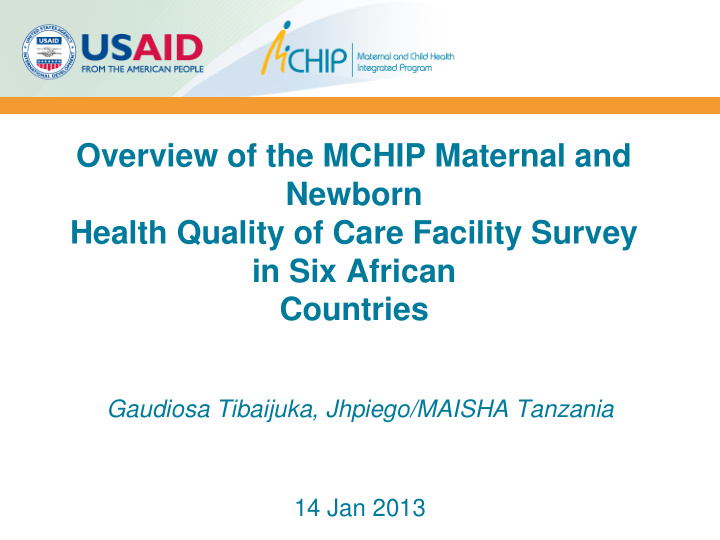



Overview of the MCHIP Maternal and Newborn Health Quality of Care Facility Survey in Six African Countries Gaudiosa Tibaijuka, Jhpiego/MAISHA Tanzania 14 Jan 2013
Quality of Care Study Overview Focuses on routine care, Core of assessment is direct prevention and observation of ANC, Labor management of the most & Delivery, and PPC serious maternal and newborn complications. WHO guidelines used as Overall goal is to support the standard of care, quality improvement . especially the IMPAC series, including Managing Complications in Pregnancy and Childbirth.
Donabedian Model Indicators measured: Indicators measured: Indicators measured: Availability of drugs, TT 2+, SBA, uterotonic Maternal mortality supplies and equipment, usage Infant mortality staff-to-patient ratios C-section rates Severe maternal morbidity Provider mix EmONC signal Case fatality rates Staff training/experience functions performed Patient satisfaction Methods used: Methods used: Methods used: Surveys, inventories, Surveys, interviews, Clinical audits, death interviews record reviews/HMIS reviews, record RARELY: Observation reviews/HMIS Graphic source: AHRQ
Seven QoC Assessment Countries • MCHIP QoC assessments implemented in seven countries in 2010-2012 but findings shared from six sub Saharan Africa countries. • Tanzania only country conducted the survey twice 4
Summary of Samples Assessed close to 650 facilities in 6 countries; observed over 2,500 deliveries and close to 3,000 ANC consultations; interviewed over 1,000 health workers. Sample Kenya Ethiopia Tanzania Zanzibar Rwanda Mada- Mozam- Total gascar bique Facilities 409 19 52 9 72 36 46 643 -Hospital 52% 100% 23% 56% 58% 75% 46% 53% -Health Center/dispensary 48% 0% 77% 44% 42% 25% 54% 47% Observations of care 2035 318 880 274 604 670 4781 9562 -Deliveries 626 192 489 217 293 347 525 2689 -ANC consults 1409 126 391 57 311 323 303 2920 Health workers interviewed 249 79 206 51 146 140 186 1057 5
Study Procedure, use of checklists Data collection done in one visit per health facility over a 3-4 day period Smart phones/tablet used for data collection; sent directly to a centralized database
Screening for Pre-eclampsia in Labor & Delivery Note: 100% Bars represent average scores 90% High-low bars show the range. 80% 70% 60% 50% 40% 30% 20% 10% 27% 77% 22% 7% 0% Asks about signs of PE/E Initial blood pressure Both PE/E screening Tests urine for presence (1) check elements of protein 1) headache/blurred vision or swollen hands/face (any danger sign Kenya and Ethiopia) Bars represent average of mean scores for all countries and high-low bars show the by- country range.
Supplies and Equipment for PE/E 100% 90% 80% 70% 60% 50% 40% 30% 20% 10% 90% 34% 55% 0% Functioning blood pressure Urine testing capabilities Magnesium sulfate in DR apparatus Bars represent average of mean scores for all countries and high-low bars show the by- country range.
Health worker knowledge of PE/E signs and management 100% 90% 80% 70% 60% 50% 40% 30% 20% 10% 45% 44% 88% 56% 40% 32% 0% Essential Examination Diagnosis Action to take Actions if Actions to take supplies & actions presented with 1hr later equipment convulsions 9 Bars represent average of mean scores for all countries and high-low bars show the by- country range.
Partograph Usage 100% 90% 80% 70% 60% 50% 40% 30% 20% 10% 57% 44% 20% 32% 27% 0% Partograph used during Partograph initiated at Plotted at least every Delivery information BP recorded at least labor appropriate time half hour during labor recorded every four hours Bars represent average of mean scores for all countries and high-low bars show the by- country range.
Management of PPH Mrs. A (para 1) was attended by a Item Total nurse/midwife. During the initial assessment, Cases of PPH observed 74 the provider did not ask about bleeding during Type of treatment provided previous pregnancies. She had a -massage the fundus 33 spontaneous vaginal delivery at 4:30 p.m. -repair of lacerations 29 AMTSL was not conducted: oxytocin was -manual removal placenta 22 given 17 minutes after delivery and no CCT or -bimanual compressions 2 uterine massage was performed. The provider -blood transfusion 4 did not assess completeness of placenta and membranes and did not check mother’s vital Medications provided signs 15 minutes after birth. PPH occurred at -oxytocin 36 5:16 p.m. The provider massaged the uterus and gave incorrect dose of oxytocin at 5:16 Outcomes p.m., checked and found a laceration that was Surgery 9 repaired at 5:35 p.m., and bleeding stopped. Maternal deaths 0 Outcome: mother and baby went to recovery ward together.
CONCLUDING THOUGHTS
Measuring QoC by Direct Observation Gold standard Eliminate some biases Gather details that mothers don’t know Rich data • By facility level, provider type, etc. • Management of complicated cases • Observer comments
Measuring QoC Cost & timing Data collectors with clinical experience Intensive training: role playing, observing simulations, inter-rater reliability testing, practice in field L&D: waiting for cases, progress of labor Hawthorne effect
Acknowledgments PI Linda Bartlett and U.S.-based study team members: Barbara Rawlins, Jim Ricca, David Cantor, Bob Bozsa, Patricia Gomez, Joseph de Graft Johnson, Rebecca Levine, Eva Bazant, Sheena Currie, Jeff Smith, Stella Abwao Ministries of Health, MCHIP/Jhpiego country offices, and providers and clients of the study facilities Data collection teams in each country 15
THANK YOU! www. www.mchip. p.net QoC reports available at: www.mchip.net/qocsurveys
Recommend
More recommend